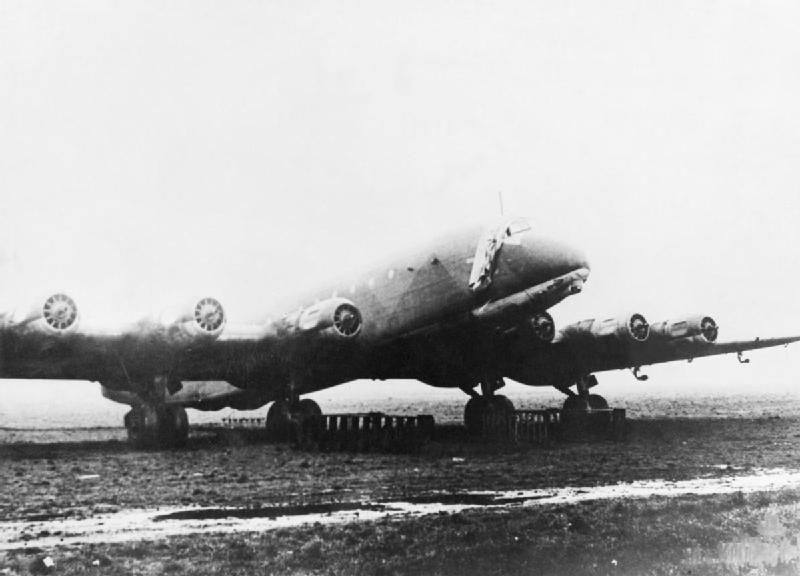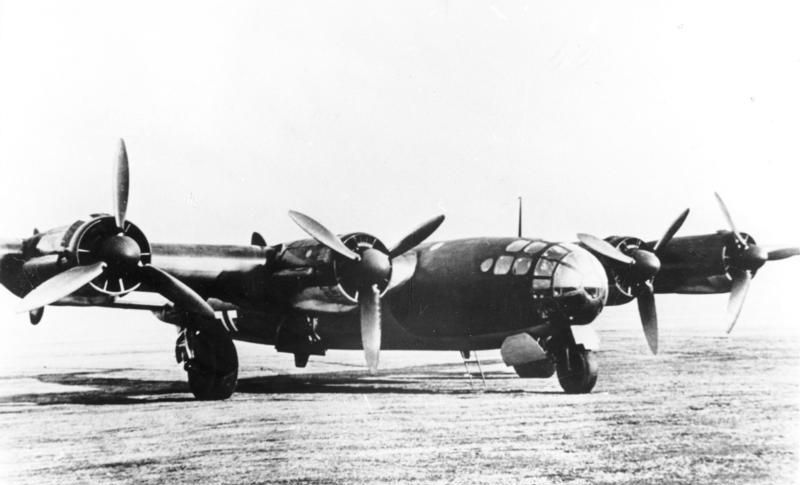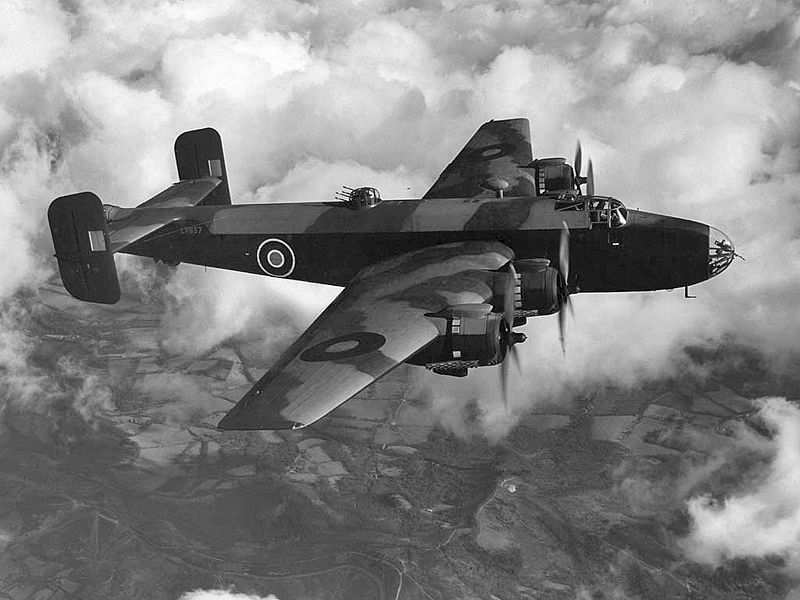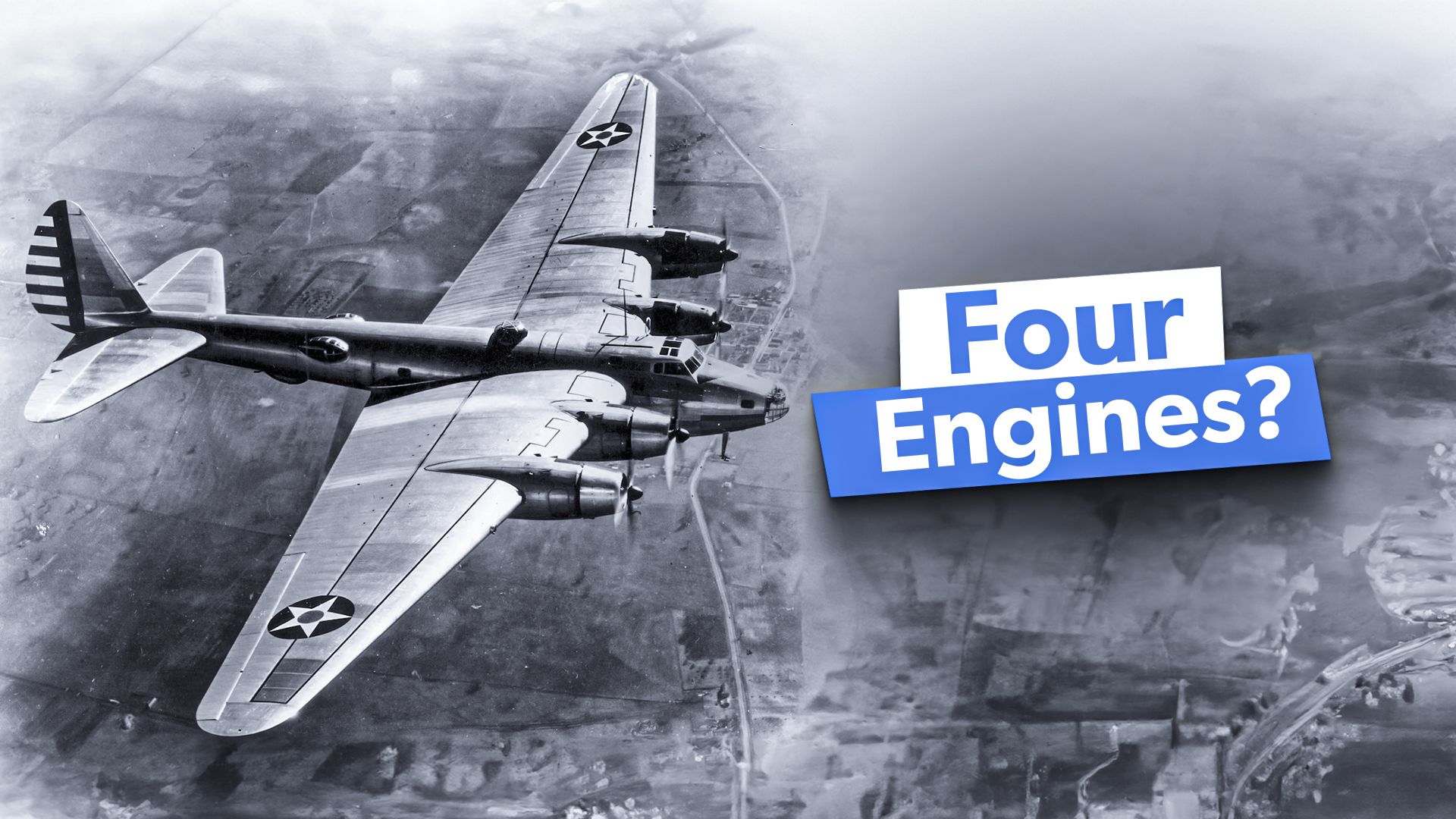Summary
- Most WWII four-engine planes in WWII were heavy (strategic) bombers, with the B-17, B-24, and B-29 being iconic American examples.
- Axis bombers like the Piaggio P.108 and the Messerschmitt Me 264 also played a part in the war effort.
- The Halifax and the Lancaster were crucial bombers for Great Britain during WWII, contributing to key missions.
Well, the short, ultra-abbreviated answer to that question is “Mostly heavy bombers AKA strategic bombers.” But eh, what fun would it be reading a military aviation article consisting of a measly 15 letters? In the world of intra-service rivalries (not to be confused with interservice rivalries), fighter pilots tend to get more glory, but bomber pilots always have the comebacker, “Fighter pukes make movies. Bomber pilots make *history*!”)

Related
Top 5 Historic Military Aircraft That Changed Aviation
Many military aircraft have made their mark on aviation history. But five in particular have been true game-changers.
(Yes, I realize that’s a fighter plane in the featured image of the article I just linked.)
Along the lines of making history, there’s a cynical saying that “History is written by the victors.” Granted, the winning side of WWII, the Allies, certainly made more successful use of four-engined bombers during that war, and it’s those particular warbirds that are best remembered by most military history buffs. But the Axis powers weren’t total non-players in the heavy bomber/strategic bomber game. For the sake of being fair and balanced, we shall examine some of those Axis bombers first before moving on to the Allied examples.
Fascist Italy: Piaggio P.108 Bombardiere
Of all the Axis four-engine bombers on the list, this one was the most successful of the bunch, in terms of production numbers and actual combat usage alike (rather ironic in light of the fact that Mussolini’s Italy was the first of the Axis Powers to capitulate).
The Bombardiere made its maiden flight on November 24, 1939, and was officially introduced into operational service with the Royal Italian Air Force (Regia Aeronautica Italiana) (RAI) in 1942, with production numbers topping off at 36 (not counting the additional 12 built as transport planes) by 1945.
P.108s saw action over Gibraltar, North Africa, and Sicily.
Imperial Japan: Kawanishi TB (Toyo Bakugeki) /KX-9 and Nakajima G10N Fugaku (富岳 or 富嶽; “Mount Fuji”)
These would-be warbirds never made it past the proposal stage, which probably explains why there’s such a dearth of information on it. As the Japanese themselves might say, “仕方ない。/shikata nai (It cannot be helped).”
As noted by Military Factory:
“The quest for the IJA [Imperial Japanese Army) of World War 2 to obtain a four-engine strategic bomber led to the ultimately-abandoned Kawanishi TB.”
So then why was it abandoned? That same article explains:
“Design work on the TB wrapped in mid-January of 1944 under the guise that it was being developed as a cargo/transport plane. Later that month, the competing Nakajima G10N Fugaku heavy bomber proposal was accepted by representatives of both services ahead of the Kawanishi TB — which led to an immediate end of the TB program.”
The Fugaku would fare no better; Imperial Japan’s ever-deteriorating war situation resulted in the project’s cancellation in 1944 before any prototype was ever built.
Again, 仕方ない。/shikata nai.
Nazi Germany: Messerschmitt Me 264 and Junkers Ju 390
Nazi Germany’s attempts at four-engine bombers fared better than Japan’s *relatively* speaking, by which means at least German bomber designs did at least come io fruition in a few prototypes being built. “A few,” as in a whopping three for the Me 264 and two for the Ju 390. These two planes made their maiden flights on December 23, 1942, and October 20, 1943 respectively.


Both of these aspiring Luftwaffe bombers were competing for the Reichsluftfahrtministerium‘s (the German Air Ministry) Amerikabomber (America Bomber) program, which envisioned a strategic bomber capable of attacking New York City from bases in France or the Azores.
The Me 264 was abandoned after those three specimens were built in order to allow Messerschmitt to concentrate on fighter production and the Ju 390 was selected in its place. From there, the Me 264s went out in rather ignominious fashion: On July 18, 1944, an Allied air raid damaged the first prototype and destroyed the third one; no effort was made to Prototype #1. As for Prototype #2, it was lost even earlier, in a late 1943 bombing attack.
As for the Ju 390, its selection over the Me 264 turned out to be a slim moral victory at best. On paper, it was more versatile than its Messerschmitt competitor, as it was also intended for use as a heavy transport and maritime patrol craft.
The problem is, only one of the two Ju 390 built actually ever flew, with the second one never quite being completed. The contracts were cancelled on 20 June 1944 and all work ceased in September 1944. The one flying specimen was stripped of parts and finally destroyed in late April 1945 tp prevent it from falling into the hands of the approaching US Army.
Speaking of the US Army, now we turn to the war-winning four-engine warbirds…
United States of America: B-17 Flying Fortress, B-24 Liberator, B-29 Superfortress
What could I possibly add about these three legendary American bombers that hasn’t already been written? Three of the most iconic bombers of all time; the B-17 and B-24 took the daylight precision bombing campaign to the industrial heart of Nazi Germany whilst the B-29 did the same thing to Imperial Japan (with some nighttime firebombing missions mixed in as well), and needless to say, it was the “Superfort” that finally ended WWII *and* ushered in the Atomic Age via the A-bombs on Hiroshima and Nagasaki.
Arguably, the B-24 is the least-heralded of the bunch, never mind that the Liberator had a longer range, greater speed, and a bigger payload than its “Flying Fort” comrade-in-arms.; when I wrote an article on the Liberator for 19FortyFive back in May 2023, my then-Editors conferred the title “B-24 Liberator: The Forgotten World War II Bomber?”

Related
Are There Any B-24 Liberators Still Flying Today?
The aircraft took to the skies after a break of over 20 years.
As for the B-17, it actually had some rather inauspicious beginnings, almost being killed in its infancy by a rather visionary-deficient brass, as explained by the National Museum of the United States Air Force:
“This plane, although destined to change the complexion of aerial warfare, initially failed to convince the Army’s General Staff of its merits and capabilities. As a result, the General Staff directed that the major portion of funds for the purchase of bombers be spent for cheaper two-engine Douglas B-18s, rather than more costly four-engine B-17s, believing the latter type an expensive and unnecessary luxury.”
Great Britain: Avro Lancaster and Handley Page Halifax
The Halifax was to the Lancaster what the Liberator was to the Flying Fortress, i.e. the less heralded and less beloved of the pair. And that’s a bit of a bloody shame, as the Halifax was a very capable and accomplished bombers in its own right; among other things, it accounted for 25 percent of the total bomb tonnage dropped by the Royal Air Force (RAF) on Germany during WWII, and on July 24, 1941, Halifaxes belonging to No. 35 and No. 76 Squadrons of the RAF attacked the Kriegsmarine battleship Scharnhorst as it was berthed at the port of Brest in northern France, severely damaging the large warship and necessitating its move to a safer location,


To gain a greater appreciation for the story of the Halifax crews, read the 2020 book “Above Us, the Stars” by Jane Gulliford Lowes.
Photo: Christian D. Orr | Simple Flying
As for the Lancaster, while it didn’t drop atom bombs like the B-29, it definitely made its own high-impact mark on bomber history by dropping the largest pieces of conventional ordnance of the war, the 12,000-lb (5,443.1 kg) Tallboy and ultimately, the 22,000-lb (9,979 kg) Grand Slam Earthquake bombs.
Soviet Union: Petlyakov Pe-8 (Петляков Пе-8)
This was “Uncle Joe” Stalin’s only four-engine bomber of “The Great Patriotic War” (Вели́кая Оте́чественная война́/Velikya Otechestvennaya voyna; the preferred label for WWII by the Soviets and post-Soviet era Russians alike).


In his 1983 book “The Soviet Air Force At War” (part of Time-Life Books excellent Epic of Flight series), author Russell Miller assessed the Pe-8 thusly:
“The only Soviet heavy bomber to serve in the War, the four-engined Pe-8 could carry almost 8,800 pounds [3,991.6 kg] of bombs 2,920 miles [4,699 km] to hit targets in Germany and the Balkans. But its main role was as a long-range VIP transport, most notably in 1942 when it flew diplomats from Moscow to London and Washington for lend-lease [sic] talks.”
The Pe-8 made its maiden flight on December 27, 1936, and was officially introduced into operational service with the Rodina (“Motherland“) in 1940, with total production topping off at 93 airframes by 1044.
Some might’ve been expecting the Tupolev Tu-4 to be listed here. However, whilst that plane was indeed a “reverse engineered” (read: deliberate ripoff) B-29, it didn’t debut until after WWII ended, specifically on May 19, 1947.




